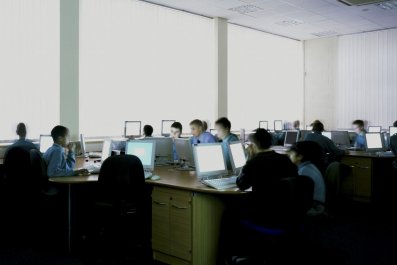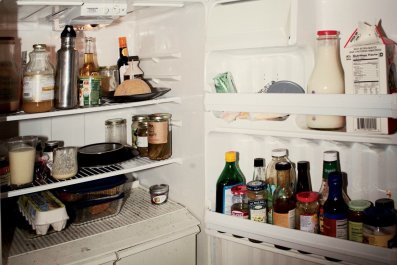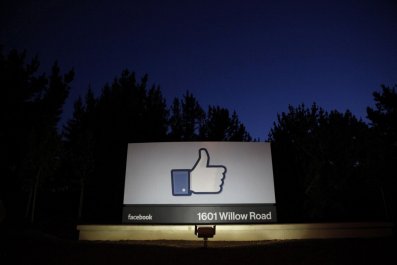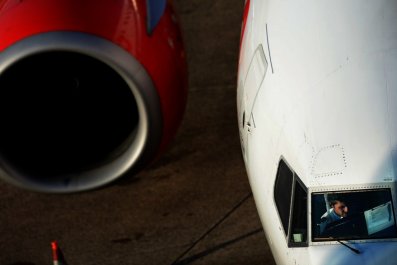Watch how easy it is to accidentally kick off a global epidemic.
Dozens of tractors knock down trees in the forests in the outskirts of Chiang Mai, Thailand, clearing land for a new housing development. The construction destroys the natural habitat of short-nosed fruit bats. One of those displaced bats—infected with some form of animal virus—drops a chewed-up apple core in a nearby backyard farm. A pig eats the leftover apple and then mingles with the dozens of other animals on the farm. Eventually, the family slaughters one for dinner, not knowing that the animal carries the bat virus.
The daughter gets pig's blood on her hands as she helps her mother prepare dinner. The family takes the roast pork to a nearby house party. At this point the virus is no longer in the meat, but has spread to the young woman. It's also now airborne and, over dinner, spreads to the rest of the partygoers, all sharing the same sick meat and air. Some neighbors take the respiratory virus home to their backyard farms, but some work in the densely populated city, and they take it to their shops and restaurants. One of them travels all the way to New York City, where he lives, works and travels on the subway with thousands of fellow New Yorkers.
Within weeks, a global pandemic looms. And millions of lives and dollars are at risk.
Scientists don't know the exact origins of pandemics—such as the 2009 H1N1 swine flu virus, which ultimately killed an estimated 284,500 people worldwide—but many say the scenario above is a good approximation. They also say that the pandemics we've seen so far are a bout of sniffles compared to what might be on the horizon. Jennifer Olsen, the manager of the pandemics arm of the Skoll Global Threats Fund, a nonprofit whose employees served as scientific advisors for the movie Contagion, says a disaster like the one depicted in that film is feasible. "It's not a question of if there will be a global pandemic," Olsen tells Newsweek. "It's a question of when."
Scientists don't know when this will happen, but they do have some idea of where. Southeast Asia, with its humid tropical weather, densely populated spaces, high rates of tourism and, especially its many backyard farms, is a hotbed for infectious diseases and likely ground zero for a global pandemic.
That's why the Skoll fund is coordinating a new digital disease surveillance initiative in Chiang Mai focused on early detection, which public health experts say will be critical in stopping future outbreaks from becoming pandemics.
Speed is key. Two decades ago, it may have taken health officials a month to detect an infectious swine or bird flu virus. By 2009, with the advent of new communications technology and surveillance systems, public health officials were able to cut that down to about two weeks. A working group in Chiang Mai, led by the Skoll fund, says their early detection model could cut detection time to days.
The group envisions a time when, once a week, people all over the world open an app on their mobile phones and report on their health, the health of their family, pets and animals, and anything unusual in their environment, ranging from an unusual rise in the price of meat in the local market to the state of water in a nearby lake.
The team is thinking big, but for now, the project is focused on one relatively small region, where all the local stakeholders are already on board. The project will need significant funds to pay for staff time to create the tool; to purchase server-cloud space to work off of; and to finance outreach programs for communities and appropriate agencies. Skoll intends to fund most of the project, but says the financial details will ultimately depend on the proposal, action plan and funding request they will receive later this year. They will also look for a local funding partner.
Assuming the money comes through, epidemiologists, hospitals, and animal and human health authorities, would have "a single, robust way to see of all of this data in real time," Olsen says—a website or a mobile app, for example. They could spot anomalies and coordinate instant response efforts, stopping outbreaks before they spread.
For years, it took a visit to the doctor to reveal a new outbreak. If a doctor noted an unusual case, he or she reported it to local health officials. They, in turn, waited to see numerous instances pop up before reporting to their ministry of health—after all, they didn't want to raise a false alarm or needlessly waste resources. The ministry of health, in turn, also waited for a series of seemingly connected reports before advising world health bodies such as the World Health Organization (WHO) or the United Nations. This complex reporting process resulted in considerable lag time between disease outbreak and detection.
{C}
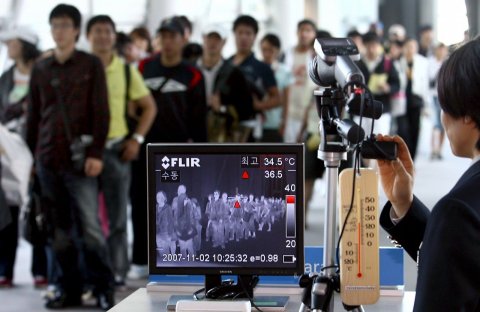
When the Internet spread across the globe the chances of catching a pandemic before it starts began to improve. What experts call "digital disease detection" began in the mid-1990s, when independent websites like Program of Monitoring Emerging Diseases (ProMed) began to cull and collate information from official public health sources. Later, other sites developed more complex tools that scraped the entire Internet for infectious disease information—Google.org, for example, began an experiment in 2008 with "Google Flu Trends," which collects data from those impacted by disease via their search queries. These days, flu-tracking sites and apps like "Flu Near You" attempt to improve on this model by reaching out directly to people, enabling them to self-report flu-related symptoms.
Good data hasn't been the only impediment in this chase. After the 2003 SARS outbreak, the global public health community criticized China for how it handled the epidemic. Some suggested the country failed to report early enough; others argued that China intentionally underreported.
That debacle prompted the WHO to change its International Health Regulations, and add new provisions requiring broader and timelier reporting of outbreaks of international concern. These changes took effect in 2007. Speed wasn't the only concern; the WHO also called for public health officials to more closely monitor ecological factors and animal health. That's because about 75 percent of recently emerging infectious human diseases are zoonotic, or of animal origin, as are 60 percent of all human pathogens, according to the Centers for Disease Control and Prevention (CDC). When it comes to understanding the spread of infectious diseases in humans, UCLA associate professor James Lloyd-Smith says, "It's clear, animals are the place to look."
The new WHO regulations, along with the deadly outbreaks of SARS and H1N1 in the last decade, have spurred Southeast Asian countries like Thailand to set up animal-specific surveillance systems, where volunteers and veterinarians go door to door every six months or year to ask farmers about their animals, and sometimes, test them for infection.
These programs have been mildly effective, but in many ways they are a step backward: The foot-on-pavement techniques and annual scheduling make no use of modern communication technologies. The Chiang Mai project is trying to change that. According to Nathalie Sajda, project manager at OpenDream, a technology partner for the Chiang Mai initiative, the project is the first anywhere in the world with digital animal health surveillance through citizen-generated reporting. Instead of requiring the manpower and resources of hundreds of volunteers, burning gas and knocking on doors, in order to collect information only once or twice a year, there would be immediate, consistent and well-organized data.
In March, scientists in human and animal health, government agencies, hospitals, the local zoo and university, coders and technology partners gathered in Chiang Mai for an intensive four-day symposium and hack-a-thon. They developed software prototypes for the initiative, and generated ideas around marketing, incentives and data analytics. The hope is to roll something out by August in Chiang Mai, and be able to duplicate or scale the project to other areas within two years.
The initiative is not without its challenges. For example: how to verify the accuracy of the information generated. "How do you separate the wheat from the chaff?" asks Lloyd-Smith. "When you are dealing with that kind of self-reported, high-volume data, how do you filter real-time information, identify what's really an incident you need to respond to versus what's a normal event?"
Deterrents to accurate reporting and participation include privacy concerns, fear of repercussions, and a lack of urgency or understanding around infectious diseases. "People may not initially be so eager to share this sensitive data," says Sajda. "There are a lot of questions: Will it increase my insurance? Will the government come and take my other cows?"
The initiative is considering incentives for participation, such as honorary badges or a "fast pass" to the overburdened local hospital. It has already received endorsement from the monks and temple, which are powerful shapers of public opinion. "Our goal is to create trust," Sajda tells Newsweek. "And a very deep public awareness: If you want good public health, which concerns all of us, you need to share data."
As for privacy, the initiative would limit the sensitive, personally identifying data it collects, such as names and addresses. "We're not trying to show an individual as patient zero in case of an epidemic or pandemic," she says.
The Chiang Mai group still hasn't answered questions about who will have access to the data, how protected it will be, how long it will be retained and how it will be used. It also has not fully developed its technology solutions for reporting and analyzing data. And yet, there is excitement concerning the approach. "It's possibly less accurate but far faster, cheaper and a very, very powerful accelerator of the public health systems already in place," says Robert Kirkpatrick, director of the U.N.'s Global Pulse (an innovation lab using big data to aid development) and who wasn't involved with the Chiang Mai initiative.
The team in Chiang Mai believes that the approach of the future will take advantage of where people already are: on their smartphones. "When you have all of these people wasting so much time looking at a little screen," says Sajda. "How can you capture a fraction of that to support public health?"
The answer could end global pandemics.






